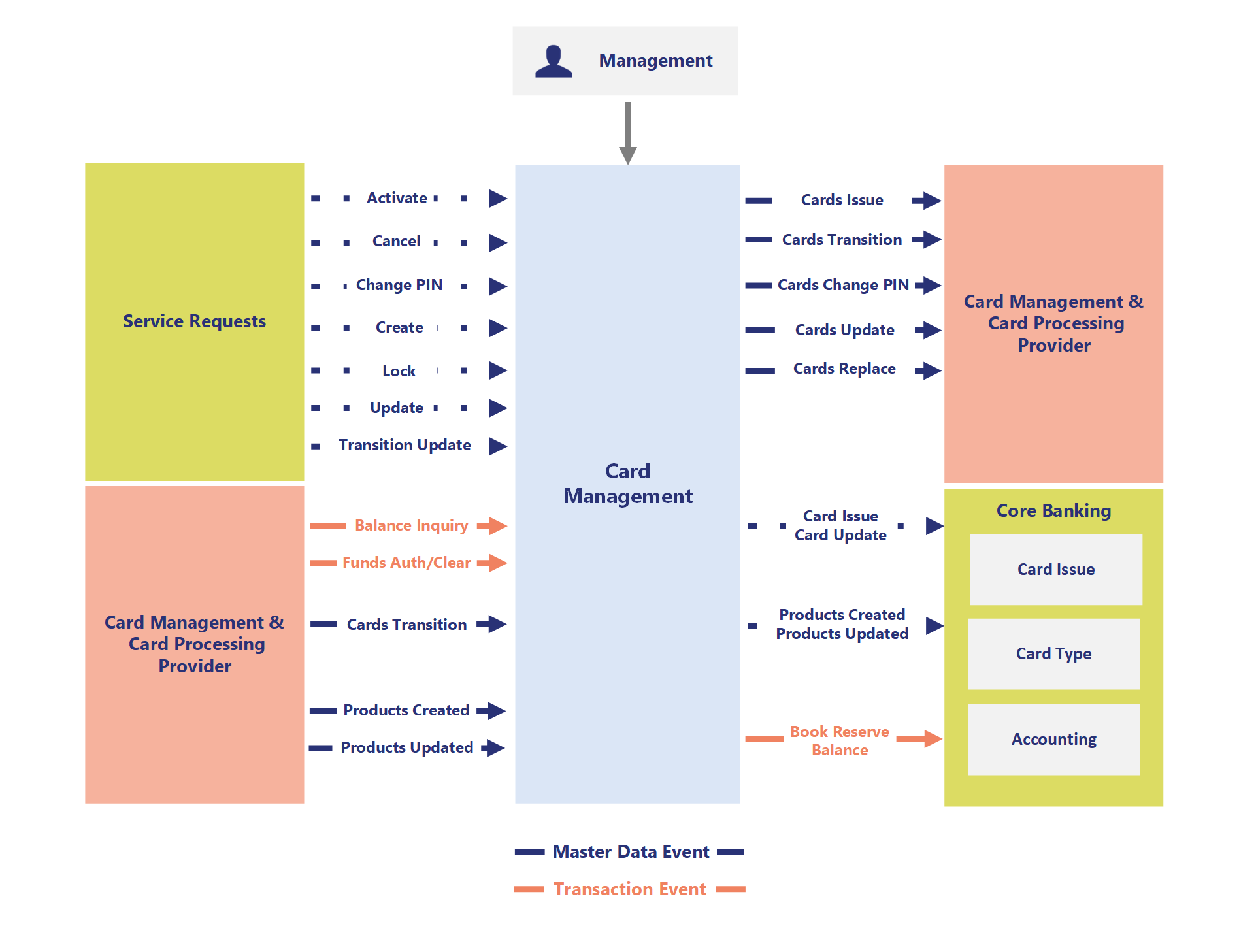Card Management Domain Adapter Guide
This guide centers on a context diagram representing the interactions of the Card Management System with its surrounding entities. The diagram, which focuses on the card lifecycle, events and processes, is followed by a description of the roles, responsibilities, and flows.
Note: Click the diagram to expand.

Service Requests
Note: See top left component of the context diagram.
Roles
This component represents user-initiated actions and requests submitted to the Card Management System. These requests could come from users, systems, or customer service representatives.
Key Actions
- Activate: Activates a newly issued or previously locked card.
- Cancel: Cancels an existing card, typically when it is no longer required.
- Change PIN: Updates the card's PIN for security or user preference.
- Create: Issues a new card request, which involves interacting with downstream providers.
- Lock: Temporarily locks a card, often for security reasons (for example, suspected fraud).
- Update: Updates cardholder details or card attributes.
- Transition Update: Reflects changes in the card's status (for example, transition from inactive to active).
Flow
Service requests flow into the Card Management System to trigger lifecycle actions.
Card Management
Note: See central component of the context diagram.
Role
The Card Management System is the primary orchestrator, coordinating all card-related processes, data management, and integrations. It processes incoming requests and delegates tasks to downstream systems.
Functions
- Handles card lifecycle actions triggered by Service Requests (for example, Create, Activate, Cancel).
- Publishes Master Data Events to notify downstream systems of updates (for example, products created, products updated).
- Facilitates Transaction Events for financial operations such as balance inquiries and funds authorization.
Data interaction:
- Receives service requests, processes them, and communicates with downstream components.
- Ensures card data integrity and consistent state transitions.
Card Management and Processing Provider
Note: See top right component of the context diagram.
Roles
This external provider manages backend processes related to card issuance, updates, and lifecycle transitions.
Key interactions with Card Management
- Cards Issue: Fulfills card issuance requests (for example, printing and shipping).
- Cards Transition: Handles transitions like upgrades or replacements.
- Cards Change PIN Processes secure PIN changes.
- Cards Update: Applies general updates to card attributes.
- Cards Replace: Processes requests to replace lost, stolen, or damaged cards.
Flow
Card Management sends instructions to the provider for execution. The provider sends back status updates and notifications.
Core Banking
Note: See bottom right component of the context diagram.
Role
The Core Banking System supports financial operations, enabling real-time card transactions and reconciliation with user accounts.
Key Functions
- Accounting: Manages financial records and reconciliation of transactions.
- Card Issue: Associates newly issued cards with customer accounts.
- Card Type: Links card types (for example, debit, credit) with banking products.
- Balance Inquiry: Provides real-time account balance information for the cardholder.
- Funds Authorization/Clearing: Authorizes and clears financial transactions initiated via cards.
Flow & Actions
Card Management interacts with Core Banking for financial operations, ensuring synchronization of cardholder account data. Transaction Events, such as balance inquiries and funds authorization, flow in real-time.
- Quotes and Transfers: The system validates the inputs, processes the requests, and sends back calculated quotes or transfer confirmation statuses.
- Transfer List and Details: The system fetches the transaction history or pending transfers from the appropriate data stores and returns it to the user.
Card-related Events
Master Data Events
Note: Master data events = dark blue dotted lines.
Role
Master data events represent updates or changes to card-related metadata, such as product configurations or card state transitions. These events ensure downstream systems remain in sync with the latest card configurations and status.
Events:
- Cards Transition: Indicates a change in the card's lifecycle status (for example, activation, deactivation, or upgrade)
- Products Created: Signals the creation of new card-related products or features (for example, a new card type such as Platinum Debit).
- Products Updated: Indicates modifications to existing product configurations (for example, changing product fees or benefits).
- Cards Issued: Notifies downstream systems when a card is successfully issued.
- Cards Updated: Reflects general updates to card metadata.
- Cards Replaced: Indicates that a card has been replaced due to being lost, stolen, or damaged.
Transition Events
Note: Transition events = coral solid lines.
Role
Transaction events capture real-time activities related to the card's financial operations and balance management. These events ensure accurate synchronization with core banking systems and other financial entities.
Events:
- Balance Inquiry: A real-time request to fetch the current balance associated with a card.
- Funds Authorization/Clearing: Tracks and processes financial transactions initiated by cardholders, including reservation of funds and settlement.
Management
Note: See top of context diagram.
Role:
Management oversees observability and operational health of the Card Management System. This includes providing insights and control to operators.
Functions:
- Observability: Logging, metrics, and traces for the system's behavior.
- System Management: Readiness checks, heartbeat monitoring, state management, and enabling detailed logging for debugging.
- Integration: In SaaS environments, management is typically integrated with an overarching system management solution.
Related Guides
See also:

